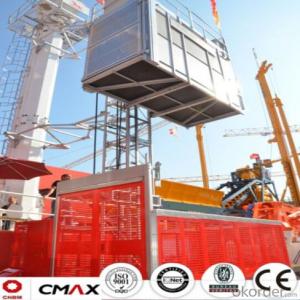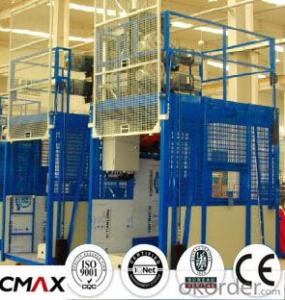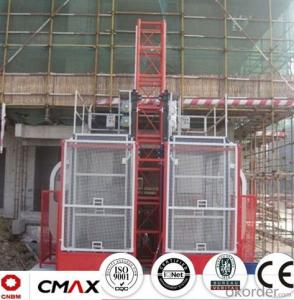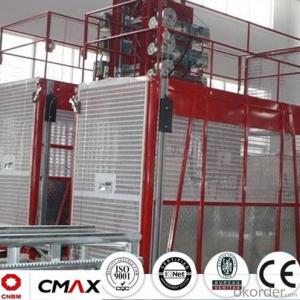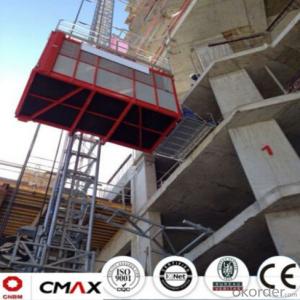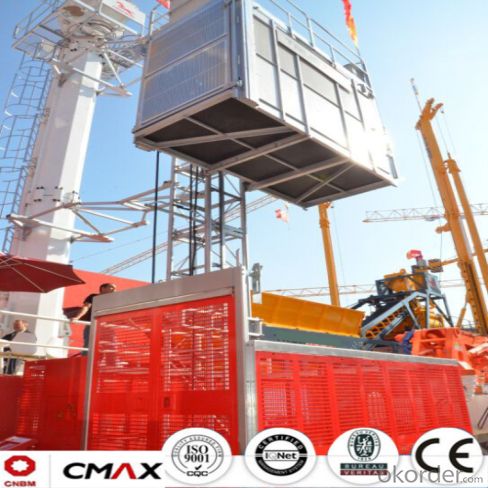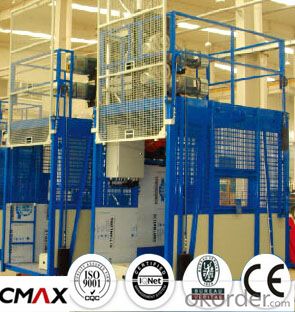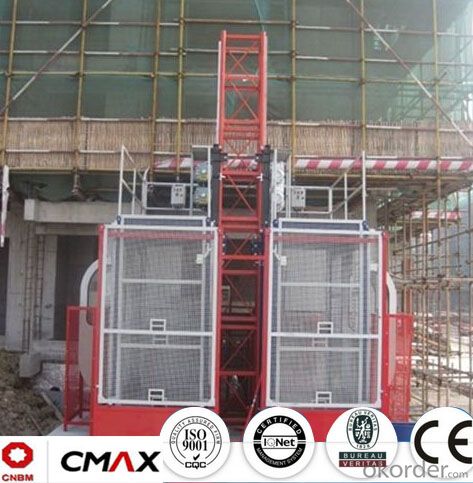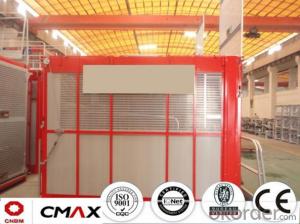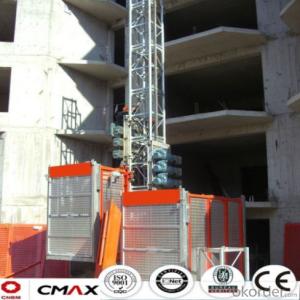Building Hoist European Standard Electric Spare Parts with 2ton Capacity
- Loading Port:
- China main port
- Payment Terms:
- TT OR LC
- Min Order Qty:
- 1 unit
- Supply Capability:
- 5 unit/month
OKorder Service Pledge
OKorder Financial Service
You Might Also Like
Structure of Building Hoist Description
1.The gearing select perfect bearing,strong cables and oil seal.
2.The electrical parts select products from famous world manufacturers for example Schneider,Siemens and LG.
3.The racks and pinion select advanced material and advanced technique,which enhance the life of all parts.
4.The steel structure adopted strong steel from famous native manufacturers.
5.The surface of the steel structure can adopt paint-spray,parkerizing baking finish or hot galvanizing processing depending on users requirement.
6.The cage can be made and decorated by aluminum molded board,punched-plate or figured aluminum board.
Packaging & Delivery of Building Hoist
Packaging: nude and wooded box Delivery: 25-30days
Mains Parts of Building Hoist
1.The steel structure for example the mast, tie in and cabin ,could be all spay-painted and hot galvanized. Mast section is made with high quality Q345B which is the top standared in China.
2.Electrical parts are all adopted with Schneider , Siemens and other famous brands.
3.The electrical system can be selected with the normal control method and VVVF+PLC control way. Inverter we selected is from Schneider. Yaskawa or other world renowned brand.
4.Cabin exit door select ramping type. The ramping door looks like a bridge between the construction hoist and construction building.
5.The cabin floor is made from 3MM thickness steel riffled board(Hot dip galvanized), and 15MM thickness wooden board which can reduce the vibration and deformation a lot.
6.Driving unit is adopted the products from ZHANGJIANG and other reputed maker, or from SEW, NORD.
7.Safety system is mainly composed of electrical motor braking, anti-drop safety device, top & bottom limit switches, top & bottom 3-phase switches, door limit switches, buffer device and over-load protection. The system aims to ensure the hoist are running safely.
8.Qualification: CE, ISO9001:2008 and etc.
9.The long-term operation of CMAX building hoists testifies CMAX hoist is working performance is stable.
Building Hoist Images



Building Hoist Specification

FAQ of Building Hosit
Q: What is the building hoist main purpose?
A: Building hoist equipped with double or single cabin to transport the materials and labors up and down. It's the ideal construction equipment for vertical transportation in the field of construction.
Q: What is the main structure of building hoist?
A: The P/M construction hoist mainly contains metal structure, driving system, electrical control system, cable guide & protection system, electrical top crane and safety device.
Q: What is the meaning of the building hoist’s code?
A: Take SC200/200 for example: “SC” stands for rack and pinion hoist, “200/200” stands for double cage and capacity is 2 tons per cage. “SC200” stands for single cage and capacity is 2 tons.
Q: What is the dimension of the cage?
A: Normally the cage dimension is 3X1.5X2.5M (L/W/H) for 2t type hoist. Details should be checked according to our
quotation sheet. Also, the size can be customized according to the factual site condition. There are two doors (entrance& exit doors) for each cage, It can be produced as up & down sliding or ramping model for safety and convenience.
- Q: This question asks for a comparison between manual and automatic lifting systems used in construction equipment, highlighting their distinct features and operational differences.
- <p>Manual lifting systems in construction equipment rely on human effort to lift and move materials. They are often less expensive, require less maintenance, and are suitable for lighter loads or smaller-scale projects. However, they are labor-intensive, can be slower, and pose higher risks of injury due to the physical demands. Automatic lifting systems, on the other hand, use mechanical or electronic means to lift and move materials. They are more efficient, can handle heavier loads, and reduce the risk of injury by minimizing manual handling. These systems are often more expensive and require regular maintenance but offer precision, speed, and ease of operation, making them ideal for large-scale construction projects.</p>
- Q: This question asks for steps to ensure that lifting equipment is safe and reliable before it is used.
- <p>To ensure your lifting equipment is safe and reliable before use, follow these steps: Inspect the equipment for any visible damage or wear. Check all safety features such as hooks, cables, and brakes. Ensure that the equipment is properly maintained and serviced according to the manufacturer's guidelines. Verify that all safety certifications and inspection records are up to date. Conduct a thorough pre-use check, including testing the equipment's lifting capacity and stability. Ensure that all operators are trained and certified to use the equipment. Never use equipment that has not been inspected or is showing signs of damage. Always follow the manufacturer's guidelines and safety protocols.</p>
- Q: This question asks for the method to determine the maximum load that a single-rope lift can handle.
- <p>To calculate the load capacity of a single-rope lift, you need to consider several factors including the strength of the rope, the diameter of the rope, the angle of the lift, and the safety factor. The basic formula involves determining the maximum load the rope can bear based on its material properties and construction, which is then adjusted by the safety factor to account for dynamic loads and potential wear. The formula might look something like this: Load Capacity = (Tensile Strength of Rope 脳 Area of Rope Cross-Section 脳 Safety Factor) / (Cosine of Angle of Incline). It's important to consult with engineering standards and the lift manufacturer's specifications for precise calculations.</p>
- Q: This question asks for the process of changing the speed at which a building hoist cylinder operates.
- <p>Adjusting the speed of a building hoist cylinder involves several steps. First, ensure the hoist is turned off and disconnected from power. Check the manual for the specific model to understand the speed control mechanism, which could be a variable frequency drive (VFD), a governor, or a throttle control. If it's a VFD, adjust the frequency setting to increase or decrease speed. For a governor, you might need to change the spring tension or adjust the control valve. With a throttle control, simply turn the throttle to the desired speed setting. Always test the hoist at low loads first to ensure the adjustments are safe and effective before using it for heavy loads.</p>
- Q: This question asks for a comparison of the benefits and drawbacks of utilizing hydraulic fluids in lifting machinery.
- <p>The advantages of using hydraulic fluids in lifting equipment include their ability to transmit power efficiently, provide smooth and controlled movements, and absorb shock and vibration. They also have a high power-to-weight ratio, which is beneficial for lifting heavy loads. Additionally, hydraulic systems are relatively simple to maintain and can operate in a wide range of temperatures. Disadvantages include the potential for leaks, which can be hazardous and costly, and the need for regular maintenance to prevent system failure. Hydraulic fluids can also be environmentally harmful if not disposed of properly, and they may require specific storage conditions to prevent degradation.</p>
- Q: This question asks for the proper steps to install a building hoist, a device used in construction to lift materials and workers.
- <p>To install a building hoist correctly, follow these steps: 1) Ensure the site is suitable and inspect the hoist for any damages. 2) Assemble the hoist tower on a solid, level base. 3) Install the mast and guide rails according to the manufacturer's instructions. 4) Attach the hoist mechanism and cab, ensuring all connections are secure. 5) Conduct a thorough inspection and test the hoist's functionality. 6) Obtain necessary permits and inspections from local authorities. 7) Train operators on the safe use of the hoist. Always adhere to safety guidelines and manufacturer's specifications.</p>
- Q: Is it possible to use a building hoist for the purpose of lifting heavy objects?
- <p>Yes, a building hoist can be used for lifting large objects. These hoists are specifically designed to handle heavy loads and are commonly used in construction for lifting materials, equipment, and other heavy items. They are engineered with safety features to ensure secure lifting and are operated by trained personnel. However, it's crucial to ensure the hoist's capacity matches the weight of the object being lifted and that all safety protocols are followed to prevent accidents.</p>
- Q: This question asks for the detailed specifications and dimensions of a building hoist, which is a type of construction equipment used to lift materials.
- <p>The specifications and measurements of a building hoist can vary significantly depending on the model and manufacturer. Generally, a building hoist (also known as a construction hoist or material hoist) is characterized by its load capacity, which can range from 500 kg to several tons. The height of the hoist is determined by the number of floors it serves, typically measured in meters. The width and depth are usually around 1.5 to 2 meters, and the speed can vary from 24 to 60 meters per minute. The power requirement is often between 3 to 7.5 kW. Safety features like overload protection, emergency stop, and limit switches are also standard. For precise specifications, it's essential to consult the manufacturer's data sheet for the specific model in question.</p>
- Q: This question asks for the procedure or steps to operate a building hoist, which is a machine used to lift materials in construction.
- <p>To use a building hoist, first ensure it's properly installed and inspected. Familiarize yourself with its controls and safety features. Load materials evenly onto the platform, ensuring not to exceed weight limits. Activate the hoist by pressing the 'up' button to lift the materials. Maintain a safe distance while the hoist is in motion. Once at the desired floor, press the 'stop' button, then unload the materials. Always follow the manufacturer's guidelines and safety protocols to prevent accidents.</p>
- Q: Helped wall bar how to set up, and several layers of set a, two width, wall rod need a few meters long, what shape is the embedded parts, how much of a steel bar, Angle and wall vertical or have?
- Direct contact with the elevator company, and they give you a plan for the construction of a pre-buried piece, and the parameters of each elevator are different,
Send your message to us
Building Hoist European Standard Electric Spare Parts with 2ton Capacity
- Loading Port:
- China main port
- Payment Terms:
- TT OR LC
- Min Order Qty:
- 1 unit
- Supply Capability:
- 5 unit/month
OKorder Service Pledge
OKorder Financial Service
Similar products
Hot products
Hot Searches
Related keywords
